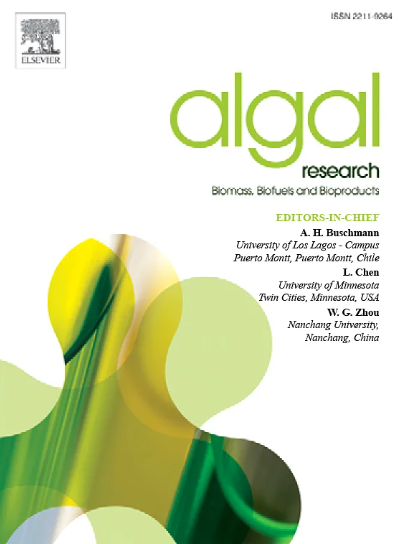Prediction of microalgae harvesting efficiency and identification of important parameters for ballasted flotation using an optimized machine learning model
IF 4.6
2区 生物学
Q1 BIOTECHNOLOGY & APPLIED MICROBIOLOGY
Algal Research-Biomass Biofuels and Bioproducts
Pub Date : 2025-02-28
DOI:10.1016/j.algal.2025.103985
引用次数: 0
Abstract
Ballasted flotation is an innovative and effective technique for the separation and recovery of microalgae. However, conventional experimental approaches to determine the optimal harvesting efficiency of microalgae are often inefficient and subjective, largely due to the varying properties of microalgae, types of ballasted agents (low-density materials, LDMs), and operational conditions. This study aims to develop a machine learning approach to establish the relationship between various features and harvesting efficiency in ballasted flotation, offering new insights for achieving efficient microalgal harvesting. The results showed that the performance of the Backpropagation Neural Network (BPNN) model outperformed other machine learning models examined in the study. To further enhance the predictive accuracy of the BPNN model, two additional optimization algorithms, Genetic Algorithm (GA) and Particle Swarm Optimization (PSO), were used to optimize the initial parameters of BPNN model. The findings demonstrated that both optimization models effectively improved the predictive ability of the BPNN model, with GA-BPNN exhibiting smaller testing Mean Absolute Error and Root Mean Square Error values (0.041 and 0.007, respectively), and a higher testing R2 value (0.923), indicating superior performance compared to PSO-BPNN. SHAP analysis identified that microalgal concentration and the diameter of LDMs were the two most influential parameters affecting microalgal harvesting. Finally, experimental validation of microalgae harvesting confirmed the model's accuracy, with results falling within a 5 % error margin of the predicted values. These insights obtained through machine learning analysis can facilitate the development of high-throughput experimental designs, which can significantly enhance the harvesting efficiency of microalgae.

求助全文
约1分钟内获得全文
求助全文
来源期刊

Algal Research-Biomass Biofuels and Bioproducts
BIOTECHNOLOGY & APPLIED MICROBIOLOGY-
CiteScore
9.40
自引率
7.80%
发文量
332
期刊介绍:
Algal Research is an international phycology journal covering all areas of emerging technologies in algae biology, biomass production, cultivation, harvesting, extraction, bioproducts, biorefinery, engineering, and econometrics. Algae is defined to include cyanobacteria, microalgae, and protists and symbionts of interest in biotechnology. The journal publishes original research and reviews for the following scope: algal biology, including but not exclusive to: phylogeny, biodiversity, molecular traits, metabolic regulation, and genetic engineering, algal cultivation, e.g. phototrophic systems, heterotrophic systems, and mixotrophic systems, algal harvesting and extraction systems, biotechnology to convert algal biomass and components into biofuels and bioproducts, e.g., nutraceuticals, pharmaceuticals, animal feed, plastics, etc. algal products and their economic assessment
 求助内容:
求助内容: 应助结果提醒方式:
应助结果提醒方式:


